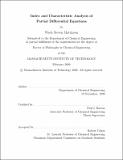Index and characteristic analysis of partial differential equations
Author(s)
Martinson, Wade S
DownloadFull printable version (1.068Mb)
Other Contributors
Massachusetts Institute of Technology. Dept. of Chemical Engineering.
Advisor
Paul I. Barton.
Terms of use
Metadata
Show full item recordAbstract
Technologies for dynamic simulation of chemical process flowsheets, as implemented in equation-based dynamic simulators,allow solution of fairly sophisticated process models, that include detailed descriptions of physical phenomena along with operating policies and discrete events. Simulation of flowsheet models with this level of detail forms the basis for a wide variety of activities, such as process optimization, startup and shutdown studies, process design, batch policy synthesis, safety interlock validation, and operator training. Technologies that make these activities possible for plant-scale models include sparse linear algebra routines, robust backward difference formula time integration methods, guaranteed state event location algorithms, generation of analytical Jacobian information via automatic differentiation, efficient algorithms for consistent initialization that may also be used to analyze the index of the model equations, automatic index reduction algorithms, and path-constrained dynamic optimization methods. An equation-based dynamic process simulator takes as input the model equations that describe process behavior, along with a description of the operating policy. The input language allows for model decomposition, inheritance, and reuse, which facilitates construction of plant-scale dynamic models. Technologies like the ones mentioned above allow the simulator to then analyze the model for inconsistencies and perform calculations based on dynamic simulation, with a minimum of intervention from the engineer. This reduces both the time and numerical expertise required to perform simulation-based activities. Results, in some cases made possible or economically feasible only by the modeling support provided by a simulator, (cont.) have been impressive. However, these capabilities apply to flowsheet models that consist only of differential-algebraic, or lumped, unit models. Sometimes behavior in a particular unit cannot be adequately described by a lumped formulation, when variation with other independent variables like distance along a PFTR, film coordinate, or polymer chain length are important. In this case, behavior is most naturally modeled with partial differential, or distributed, unit models. Partial differential equations in network flow simulations bring an additional set of mathematical and numerical issues. For a distributed model to bema thematically well-posed, proper initial and boundary conditions must be specified. Boundary condition requirements for nonlinear unit models may change during the course of a dynamic simulation, even in the absence of discrete events. Some distributed models, due to improper formulation or simple transcription errors, may be ill-posed because they do not have a mathematical property called continuous dependence on data. Finally, the model equations must be discretized in the proper manner. This thesis contributes two new analyses of distributed unit models. The first relies on the definition of a differentiation index for partial differential equations developed in this thesis. It is by design a very natural generalization of the differentiation index of differential-algebraic equations.
Description
Thesis (Ph.D.)--Massachusetts Institute of Technology, Dept. of Chemical Engineering, 2000. Includes bibliographical references (leaves 230-238) and index. This electronic version was submitted by the student author. The certified thesis is available in the Institute Archives and Special Collections.
Date issued
2000Department
Massachusetts Institute of Technology. Department of Chemical EngineeringPublisher
Massachusetts Institute of Technology
Keywords
Chemical Engineering.